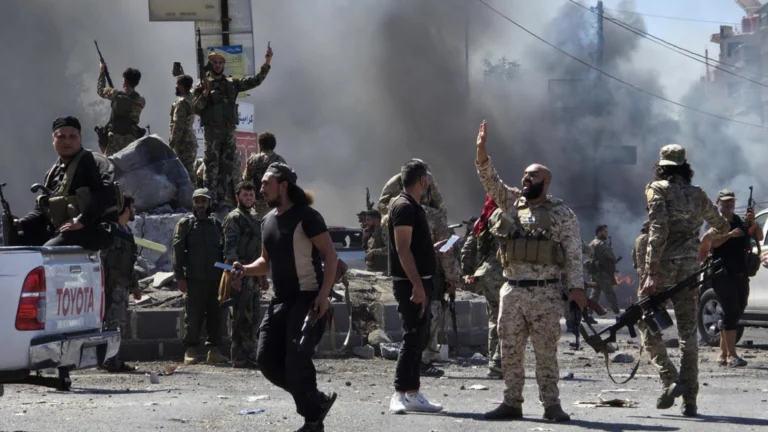Critical 1,000 Dead in Syria Sweida Violence Under Ceasefire Amid Israeli Intervention

Syria Sweida violence under ceasefire 19/7/2025
July 19, 2025 Hour: 1:23 pm
Despite a formal ceasefire, Syria Sweida violence continues, with nearly 1,000 dead and thousands displaced. The Syrian government blames Israeli intervention for the breakdown.
Related: Israel and Syria Agree to Temporary Ceasefire Amid Sweida Bloodshed
Geopolitical Context Behind Syria Sweida Violence Under Ceasefire
The Syria Sweida violence under ceasefire has exposed the fragility of recent peace efforts in southern Syria, where clashes continue despite a formal agreement allowing Syrian government forces to re-enter the region. On Saturday, July 19, 2025, Syrian President Ahmad al-Sharaa accused Israel of fueling the unrest, claiming Tel Aviv is directly involved in reigniting tensions in the strategically sensitive province.
The violence, primarily between local Druze and Bedouin militias, has left nearly 1,000 people dead and thousands displaced in less than a week. The situation has drawn international concern, particularly from the UN Refugee Agency (UNHCR) and the European Union, which have called for de-escalation and inclusive dialogue.
🔗 UNHCR – Sweida Crisis Report
Ceasefire Falters as Sweida Violence Escalates
Despite a recent agreement allowing thousands of Syrian government troops to deploy in Sweida, violence has persisted, undermining the ceasefire. Israeli airstrikes in the south and Damascus have reignited tensions, according to President Ahmad al-Sharaa, who directly blamed Tel Aviv for the resurgence of conflict.
“The Syrian state is the only force capable of preserving national sovereignty,” Al-Sharaa said in a televised address. He condemned foreign interference and rejected any attempt to turn Syria into a testing ground for separatist agendas.
The Israeli government has justified its military actions as necessary to protect Druze communities and strategic interests, but Damascus and international observers accuse it of destabilizing the region under the guise of security.
🔗 Reuters – Sweida Ceasefire Update
Syrian President Warns of Israeli Interference
In a direct statement, President al-Sharaa denounced Israeli intervention as the primary driver of renewed violence in Sweida. He reiterated that the Syrian government remains committed to restoring stability, but that external interference is obstructing peace efforts.
Al-Sharaa praised the resilience of local clans in Sweida, emphasizing that “not all Druze can be judged by the actions of a few,” in reference to armed groups involved in the clashes. He called on all local and international actors to respect the ceasefire and cease hostilities.
The province, home to a significant Druze population, has long been a sensitive area. Recent fighting has not only displaced tens of thousands but has also highlighted the fragile balance of power between Damascus, Israel, and the U.S. in southern Syria.
Complex International Involvement in Sweida
The Syria Sweida violence under ceasefire has drawn mixed international responses. Israel, which carried out airstrikes in the region, claims its actions are aimed at protecting local Druze and countering Iranian influence. However, the Syrian government and independent observers argue that these strikes have only intensified the conflict.
The United States, which coordinated with Israel to allow limited deployment of Syrian forces in Sweida, has expressed support for the Al-Sharaa government and called for a return to stability. Yet, experts note that U.S. and Israeli positions remain at odds, with Tel Aviv reportedly backing local militias in defiance of the ceasefire.
This divergence has created a tense and unpredictable environment, where local disputes are increasingly shaped by foreign agendas.
Humanitarian Crisis and Displacement
The ongoing violence in Sweida has triggered a deepening humanitarian emergency, with the Syrian Observatory for Human Rights and international aid groups reporting over 1,000 deaths and tens of thousands displaced in just a few days.
The UNHCR has warned that access to food, shelter, and medical aid is becoming increasingly difficult, particularly for vulnerable groups like women and children. Sweida’s instability is also affecting neighboring regions, with reports of refugees crossing into Jordan and Lebanon.
“The ceasefire is failing on the ground,” said a UN official. “Without urgent diplomatic action, the situation could spiral further out of control.”
International Reactions and Calls for Dialogue
The European Union has expressed growing concern over the violence in Sweida and urged inclusive dialogue to protect all communities. Meanwhile, U.S. officials have called for greater coordination between Damascus and regional actors to stabilize the south.
However, Israel’s stance remains firm, with its military citing security concerns as justification for ongoing operations. Analysts warn that Tel Aviv’s involvement could further complicate Syria’s fragile political landscape, prolonging instability and undermining the role of the central government.
“The Sweida violence is not just local — it reflects broader regional tensions,” said a Middle East policy analyst.
Conclusion: A Fragile Ceasefire in a Complex Conflict
The Syria Sweida violence under ceasefire underscores the challenges of maintaining peace in a region where local, national, and international interests collide. Despite the formal agreement and the deployment of Syrian forces, the situation remains volatile, with external actors playing a decisive role.
As the death toll rises and displacement grows, the need for diplomatic engagement and humanitarian protection has never been more urgent. The world must act — not only to stop the violence, but to uphold Syria’s sovereignty and prevent further fragmentation.
Author: JMVR
Source: AL Madayeen

